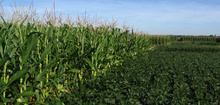
Environmental scientists and engineers rely on mathematical models. These models, which are relatively inexpensive to run, predict how complex environmental systems will respond to human activities such as landscape modification, fertilizer and fossil fuel use, and dam construction. A lot of environmental policy, especially when it comes to climate, is driven by model results.
Environmental monitoring, on the other hand, looks to the past and evaluates how the same human activities revealed themselves in empirical data. In other words, monitoring looks for changes verifiable by observation or experience, rather than just by theory or logic. Monitoring is old-school, and unfortunately, expensive.
Over the past 10 years or so, many models have predicted increased nitrate concentrations in Iowa streams driven by the Renewable Fuel Standard (RFS). This regulation required sales of liquid petroleum fuels to contain an ever-increasing percentage of renewables, most notably, corn ethanol from Iowa and other Midwestern states. Recent IIHR-published research based on water monitoring, however, casts some doubt on the previously-modeled predictions.
IIHR Researchers Keith Schilling, Chris Jones, Kung-Sik Chan, along with Anthony Seeman, Peter Kyveryga and Adam Kiel of Iowa Soybean Association and Calvin Wolter of Iowa DNR, evaluated water monitoring results from over 7,000 water samples collected in the Raccoon River watershed of Central Iowa from 1999 until 2014. Nitrate data from these samples, along with fertilization data provided by the Iowa Soybean Association, shows that Raccoon River nitrate levels may be less dependent upon corn production area than previously thought. As corn area increased (driven by the RFS) at the expense of soybean, fertilizer inputs increased a whopping 24% in the watershed. Interestingly, river nitrate did not increase and may have even slightly decreased at most watershed locations.
Intuitively, one might conclude from these data that fertilizer use efficiency improved. That was not the case, as Schilling explains. “Using measured crop yield data, we calculated the amount of nitrogen removed each year by the crops. This amount did not increase over the period of record, and may have actually decreased a little. This is because soybeans, which contain a lot of nitrogen in the seeds, were replaced by more corn, which has a lower nitrogen content.”
So this begs the question: Where did the additional fertilizer nitrogen go? Clues can be found in the several differences between corn and soybean plant growth, soil chemistry, and the decomposition of the crop residue. Decomposition of the dead soybean plant can increase the amount of soil nitrate vulnerable to loss, especially if accompanied by fall tillage. Flows of high-nitrate tile water also tend to be larger under soybean as compared to corn. So declining soybean acres may have reduced the cropped areas most vulnerable to nitrate loss. This more than compensated for the increased fertilizer inputs that resulted from more corn area. The study could prove important as farmers try to reduce loss of nutrients to Iowa streams as part of the Iowa Nutrient Reduction Strategy.
Analyses such as these that produce counter-intuitive conclusions are very difficult to defend without lots of actual data. This demonstrates the power of monitoring. Moving forward, IIHR is committed to collecting water-quality and river flow data important to Iowans with its Iowa Flood Information System (IFIS: http://ifis.iowafloodcenter.org/ifis/) and Iowa Water-Quality Information System (IWQIS: http://iwqis.iowawis.org/) web tools.
